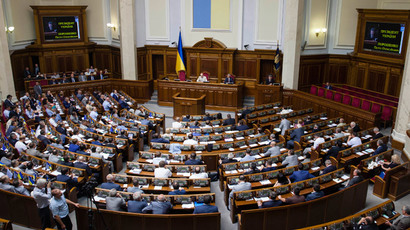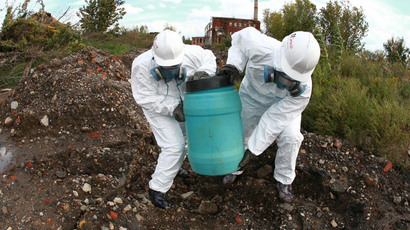‘Life stopped for us’: RT joins Lugansk residents fleeing violence in E. Ukraine
Lugansk, where the sound of gunfire is routine and basics like water in short supply, has seen thousands flee for safety. RT’s crew joined civilians, driven out of their homes by “outright panic,” on their way to a refugee camp.
LIVE UPDATES: Kiev's bloody eastern Ukraine
campaign
A missile that’s exploded somewhere outside sends a chandelier in
Valentina Lazareva’s apartment swinging. That makes her speed up
with her packing. She already sent her daughter and her
granddaughter to family friends in Russia a month ago. Now she
realizes she has to leave almost all of the possessions behind
and flee, as well to try and get her life back.
“Life just stopped for us,” Lazareva told RT’s Maria
Finoshina. “We wake up, stand in the bread line for two
hours, then get water. And then we cook a meal to eat, and the
same thing happens every day. At least when we're standing in
line we can all listen to the news on the radio.”

The house of 61-year-old Zinaida Potapova, from Lugansk Region,
came under shelling twice. She was lucky not to be hurt. She has
however seen enough to make up her mind to flee her home. Zinaida
says the decision to leave was a very quick one, dictated by
“outright panic.”
“I was at a bus stop and then I decided to leave it for some
reason,” she recalls. “As soon as I left the bus stop, a
shell exploded right behind me. Five people died. One man had his
head blown off, and a woman lost her leg. It took me three days
to get over it.”
The RT crew made sure both women were able to leave the war
behind and make it to a crowded Russian refugee camp, just over
the border with Ukraine.
Meanwhile around 250,000 people in Lugansk have been left without
the basics like water and electricity for more than 10 days. The
city is subject to siege conditions by pro-Kiev forces and under
heavy bombardment.
On the brink of survival: No electricity, water, communications
in besieged Lugansk, E. Ukraine
Over the last four days 2,160 Lugansk civilians have used a
humanitarian corridor out of the besieged city and made it to
Schastie, a town in the Lugansk Region, the press service of the
regional administration reported on Tuesday, adding that the
overall number of civilians who have used the corridor exceeds
5,500.
Schastie has been expected to become the final destination for
the Russian humanitarian convoy, according to the deputy premier
of the self-proclaimed Donetsk People’s Republic, Andrey Purgin.
“The convoy goes in the direction of Lugansk, through Kharkov
and will most probably stop in Schastie,” he said.
However, the head of the Ukrainian Interior Ministry, Arsen
Avakov, said on Wednesday the convoy will not be allowed inside
the country.
“No Putin ‘humanitarian convoy’ is going to be allowed to go
through the Kharkov Region,” he wrote on Facebook.
“Provocation of the cynical aggressor on our territory is
unacceptable. This is official.”
Earlier, the Russian Foreign Ministry received a note from the
Ukrainian government expressing its readiness
to accept the Russian humanitarian aid.
#Donetsk rocket attack kills woman and child http://t.co/6747fcdXFw
— Ruptly (@Ruptly) August 13, 2014
The death toll in the ongoing Ukraine conflict nearly doubled to 2,086 as of August 10 from 1,129 on July 26, according to “very conservative estimates” by the United Nations human rights office.
"This corresponds to a clear escalating trend," UN human
rights spokeswoman Cecile Pouilly told Reuters.
More than 60 people a day have been killed or wounded since
fighting began in mid-April in eastern Ukraine, she said. Nearly
5,000 have been wounded.














